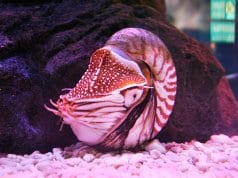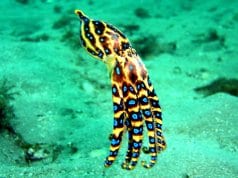Vampire squids are another deep-sea creep show. These creatures are members of the cephalopod family, along with octopus and other squid. Though they have similarities to both octopus and squid, they are technically neither. Instead, they are members of their own taxonomical order, potentially the spookiest-sounding order in the animal kingdom, Vampyromorphida. Read on to learn about the vampire squid.
Description of the Vampire Squid
The exact appearance of these creatures varies based upon location and lighting. They can range anywhere from black to deep red in color. Like octopus, they have eight arms, and each arm is connected together with webbing. The underside of each arm is lined with fleshy spines known as cirri. They have the largest eyes in the animal kingdom in proportion to body size.
Interesting Facts About the Vampire Squid
Despite their intimidating name, vampire squid are quite harmless creatures. Though they may appear spooky, especially when viewed from a dimly lit submarine in the deep sea, they pose no harm to humans.
- Vhy Vampire? – Unlike the vampire bat, these cephalopods get their name from their appearance, rather than their affinity for blood. They are dark colored, have spooky red eyes, and their webbed tentacles give the appearance of a cape.
- Spooky Spikes – When they are threatened, they will turn “inside out” by flipping their tentacles up around their bodies. This exposes the spines under their arms. Though intimidating, these protective spines are not particularly sharp, just unpalatable.
- Food for Filament – Instead of stabbing with sharp spines and sucking the blood from victims, these creatures use a much more passive feeding strategy. They have long, filament-like tentacles that are covered in sticky cells. They use these filaments to capture dead plant and animal particles that drift down from the surface.
- Pointless Protection – While most other octopus and squid squirt ink in defense, these squid do not. In the deep sea, dark colors like black and red are virtually invisible. This means that squirting black ink would be no more of a defense than squirting water at a predator.
Habitat of the Vampire Squid
When it comes to the depths, most creatures live deep, but still avoid the deepest points. These cephalopods are the exception, and it is an extreme exception! They utilize some of the deepest habitats in the ocean, as far as 3,000 ft. below sea level and more.
These habitats are known as the oxygen minimum zone. Not only does no light reach the depths, but oxygen is scarce as well. These squid are able to survive in environments with as low as 3% oxygen saturation! By comparison, the air we breathe contains about 21% oxygen.
Distribution of the Vampire Squid
As is the case with most animals that inhabit the deepest oceans, studying these creatures proves difficult. Scientists are not quite sure what the extent of their distribution is. They can only be found in the oxygen minimum layer of the deep sea in any of their distribution. Individuals have been found between 40º N latitude and 40º S latitude, in tropical and temperate oceans.
Diet of the Vampire Squid
These squid feed exclusively on detritus that floats down from the surface, and small microorganisms. They have no feeding tentacles, but instead use two long filaments that can be retracted back to the mouth. These filaments are covered in sticky cells that collect decaying animal and plant matter, as well as copepods, amphipods, zooplankton, and more.
Vampire Squid and Human Interaction
Like many other deep-sea species, these cephalopods do not interact with humans frequently. Very few fisheries deploy nets or lines to the depths necessary to reach these squid, mainly because not much else lives down there! These creatures weren’t even discovered until 1903.
Domestication
Vampire squid have not been domesticated in any way.
Does the Vampire Squid Make a Good Pet
It is nearly impossible to keep these creatures in aquariums because they require a very specific habitat, because of this they would not make good pets.
Vampire Squid Care
Little is known about the behavior of these creatures, and much less about keeping them alive in aquariums. The only specimens ever housed in a public aquarium were those at the Monterey Bay Aquarium in California.
They were kept in a low oxygen environment that replicated their natural habitat, and fed drifting food particles and small organisms. The animals on display at Monterey Bay Aquarium were also moved behind the scenes if they appeared distressed in any way.
Behavior of the Vampire Squid
There isn’t much to the behavior of these squid. They spend most of their time drifting in the deep ocean and waiting for food to come to them. They deploy their long, sticky filament tentacles, collect food, and reel it in for consumption. If they happen upon a predator they curl up their arms, revealing their spiny cirri. This threat response is often called the pineapple or pumpkin posture.
Reproduction of the Vampire Squid
Research on reproduction and development is few and far between, simply because it is difficult to study these creatures in their natural habitat, and even more difficult to keep them alive in an artificial one.
Scientists believe that because mates are so difficult to come by, females will store the packet of sperm (called a spermatophore) after breeding, so they can continue to produce offspring when there are no mates to be had. It may take as long as 400 days for the eggs to hatch, and when they hatch the young appear as miniatures of the adults.














![Red Angus Closeup of a beautiful Red Angus cowPhoto by: U.S. Department of Agriculture [pubic domain]https://creativecommons.org/licenses/by/2.0/](https://animals.net/wp-content/uploads/2020/03/Red-Angus-4-100x75.jpg)

